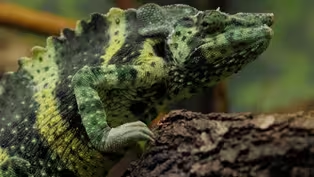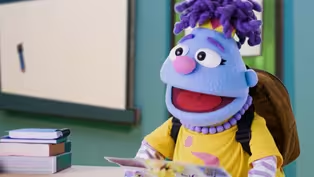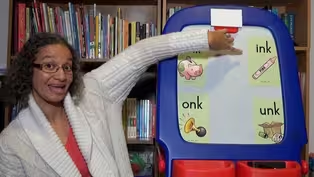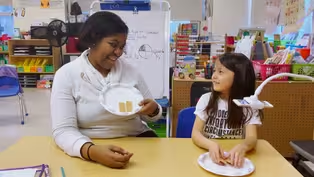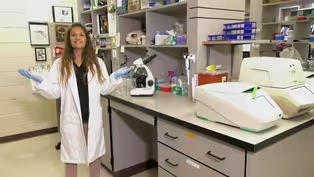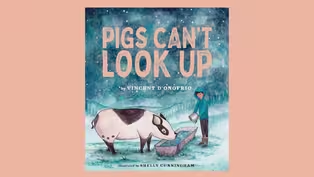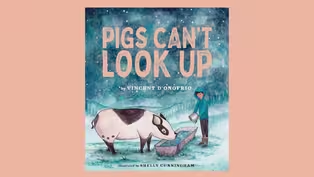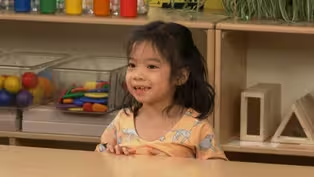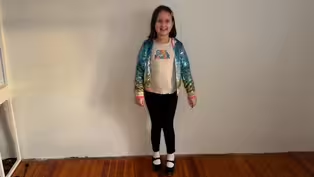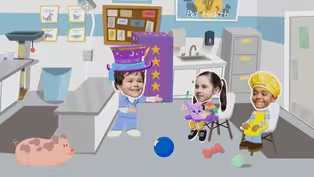
DO YOU HEAR THE “INK” IN PINK?
7/12/2024 | 57m 23sVideo has Audio Description, Closed Captions
LET'S LEARN about our five senses! Read PIGS CAN'T LOOK UP. Make a texture collage.
LET'S LEARN about our five senses! Read PIGS CAN'T LOOK UP. Make a texture collage. Meet a chameleon, a macaw, and a scientist. Use crackers to explore fractions. Solve “The Case of the Astonishing Absence.” Learn about “ink” and “onk” sounds. One-hour programs help children ages 4-7 learn while having fun. Content provided by Feel Your Best Self, Houston Zoo, Meet the Helpers, Studio in a School.
See all videos with Audio DescriptionADProblems playing video? | Closed Captioning Feedback
Problems playing video? | Closed Captioning Feedback
Let's Learn is a local public television program presented by THIRTEEN PBS

DO YOU HEAR THE “INK” IN PINK?
7/12/2024 | 57m 23sVideo has Audio Description, Closed Captions
LET'S LEARN about our five senses! Read PIGS CAN'T LOOK UP. Make a texture collage. Meet a chameleon, a macaw, and a scientist. Use crackers to explore fractions. Solve “The Case of the Astonishing Absence.” Learn about “ink” and “onk” sounds. One-hour programs help children ages 4-7 learn while having fun. Content provided by Feel Your Best Self, Houston Zoo, Meet the Helpers, Studio in a School.
See all videos with Audio DescriptionADProblems playing video? | Closed Captioning Feedback
How to Watch Let's Learn
Let's Learn is available to stream on pbs.org and the free PBS App, available on iPhone, Apple TV, Android TV, Android smartphones, Amazon Fire TV, Amazon Fire Tablet, Roku, Samsung Smart TV, and Vizio.
Providing Support for PBS.org
Learn Moreabout PBS online sponsorship- [Announcer] Ready to learn?
- And I have with me here my friend.
- Malena.
- [Announcer] It's time to share a story, read and write.
- What's this word going to be?
- [Announcer] Discover science.
- Whoa.
[child giggling] - [Announcer] Sing.
♪ How you gonna clean up the earth ♪ ♪ If you don't clean your room ♪ - [Announcer] Play, and so much more.
- We solve word mysteries!
- Word mysteries!
- [Announcer] Stay tuned for lessons and activities.
[Jordan and Jada laughing] [bright music] Funding for this program was provided by the JPB Foundation.
- Did a word that's important to you go missing?
- And now all you can feel, do, or think is the opposite of that word?
- Then call us!
I'm Sly.
- And I'm Gabby.
We're word detectives, and we solve word mysteries!
- Word mysteries!
Together we run the Wordsville Online Detective Agency.
- We'll find your missing word fast.
- Not to mention briskly.
- And swiftly.
- Yeah, we're really good with words.
- [Children] Wordsville!
- I'm so excited for Vet Wilder's brand new magic show later.
- Me too, I love magic tricks.
And Vet Wilder has a bunch of super cute animal assistants.
- The perfect combo of awe and aw.
- And to thank you for getting us the magic show tickets I've got some special surprises planned for you.
Wait, I'm getting messages, Amazing surprise ruined, spectacular surprise no more.
This isn't good.
- [Gabby] Now Vet Wilder's calling.
I wonder if it's about a word mystery.
- Word detectives, I need your help.
My magician's hat is missing.
- [Sly] Ooh, nice hat.
- Vet Wilder, why is the word astonishing written on your hat?
- Because magic tricks are supposed to be astonishing.
- I don't know that word, I'll look it up.
Astonishing means extremely surprising, amazing, spectacular, or hard to believe.
- [Gabby] Like the astonishing fact that astronauts flow in outer space.
- Astonishing is an important word.
I can't do my show without it, see?
Ta da.
Now I can't wow my audience.
- With the word astonishing missing our day will be ordinary and unimpressive.
- Ordinary and unimpressive are both opposites of astonishing.
- This must be why my amazing and spectacular surprises are ruined.
- We'd better solve this word mystery fast.
- Vet Wilder, tell us what happened and I'll animate it.
- [Vet] I was feeling nervous about my magic show, so I invited Baker Graham and Singer Melody to watch a test run and gimme comments.
I did make a few mistakes.
The cat jumped outta my hat early, the pig ran off, but I had one final trick left.
I put my astonishing hat on the table and after reciting the magic words, I went into my magician's cabinet and made myself disappear.
Only after my disappearing trick worked and I reappeared my audience and my astonishing magician's hat were gone.
And in place of my hat, I found... - Hmm, a dish and a green glitter pen.
- [Sly] I'm saving this screenshot for our case notes.
- Please hurry, bye.
- Let's get to work.
- What do we know so far?
- We know what happened.
Someone took Vet Wilder's astonishing magician's hat, and now everything has become boring, ordinary, and unimpressive.
- We also know where it happened, at the Vet Clinic, and it happened when Vet Wilder disappeared.
- The clues are a dish towel and a glittery green pen.
- [Sly] Our suspects are Baker Graham and Singer Melody.
- Now we just need to find out who did it, how, and why.
- Let's interview Baker Graham first.
[call ringing] - Sly, the spectacular friendship cake you ordered came out looking, unimpressive.
- So that's how my first surprise for Gabby is ruined.
- I'm really sorry, Sly.
- I'm sorry too.
Gabby, I wanted to wow you with a spectacular cake.
- That was thoughtful, thank you, Sly.
Baker Graham, your baking problems must be connected to our word mystery.
- Someone took Vet Wilder's astonishing magician's hat.
- You watched a test run of his magic show today.
What happened?
- He was a mess.
The cat jumped out of the hat and licked my face.
Then the pig slobbered on me.
Do you know how astonishingly unsanitary that is?
I had to wipe my face with a dish towel.
Then during Vet Wilder's disappearing act, I left to take a shower.
- You didn't say you were leaving.
- No, I didn't wanna hurt his feelings.
And, ugh, I think I need to take another shower.
Talk later.
- His dish towel ended up where the astonishing hat was taken from.
- Suspicious.
But I think it's time we interviewed Singer Melody.
[call ringing] ♪ Good afternoon, Gabby and Sly ♪ - Hello.
- Are you okay?
- No.
My astonishing singing voice that makes people cry with joy sounds unimpressive today.
Sly, there is no way I can sing that amazing friendships song you had asked for.
- And that's how my second surprise for Gabby is ruined.
- Sorry, Sly.
- That would've been surprising if the word astonishing weren't missing.
- Singer Melody, why were you at the vet clinic today?
- Vet Wilder asked for my comments on his new magic show.
Honestly, it needed a lot of work.
He made lots of mistakes.
Like not being able to find my card, the nine of hearts, three times.
- Rough.
- It was, the show was astonishing or ready for an audience.
I didn't know what to say, so I left during the disappearing act like this, bye.
- Gabby.
I'm sorry your surprises got wrecked.
- It's okay, you didn't need to get me presents just because I got tickets to the magic show.
- I didn't?
- No, there's nothing I like more than solving word mysteries with you.
- Me too.
And speaking of solving a mystery, did you see Singer Melody's comments were written in green?
- Not just any green, glitter green.
- Like the pen in the screenshot.
Let's review our case notes.
- [Sly] Baker Graham left the dish towel he used to wipe his face.
- [Gabby] and Singer Melody left the pen she was using to write her comments.
- [Gabby] She didn't think Vet Wilder's show was astonishing.
- Or ready for an audience.
She also said she didn't know what to say.
- I think it's time to show everyone how this word mystery happened.
[call ringing] Now, presenting the Word Mystery animated reenactment of The Case of the Astonishing Absence.
Thanks for coming to the test run of my magic show.
[cat meows] Oops.
- [Gabby] Ew, kitty cat.
- [Sly] Moving on to the next trick.
- [Gabby] Piggy.
- [Sly] I'm gonna need an audience volunteer.
- [Gabby] Pick me!
- Is this your card?
- Nope.
- How about this.
- Nuh-uh.
- Or this one?
- Not even close.
- [Sly] Moving on, this final trick will astonish you.
I'm going to disappear.
- Astonish you?
I gotta go take a shower.
This show needs a lot of work.
- Ta da!
Singer Melody is who did it?
[Baker Graham gasps] - Singer Melody, how could you?
- She grabbed it when Vet Wilder disappeared, that's how.
- She didn't think his magic show was at all astonishing or ready to impress an audience, that's why.
- Vet Wilder, I should have talked about how to make your magic show more astonishing.
Not taking your hat so you couldn't perform at all.
I'm so sorry.
- I forgive you, I'm gonna come up with some new tricks.
I just need my hat back.
- I'll help you, and bring you your hat.
- My astonishing hat is back on my head where it belongs.
Hmm, what's this I found?
Ta da, the nine of hearts!
- Wow, you found my card!
- I did, and I promise way more amazing magic tricks at my show.
♪ La la la la ♪ And with my voice back, I'll be able to sing your astonishing friendship song, Sly!
- It smells like Gabby's astonishing gingerbread cake is ready!
- Thanks, word detectives.
- Thanks, word detectives.
- Wow, so many special surprises.
- This once ordinary and unimpressive day is back on track.
- I can't wait for all the fun we're gonna have spending time with our astonishing friends.
- Yes!
[bright music] - Hi, friends, my name is Anna.
This is Jada, and this is Jordan and we were just about to read a story together.
Would you like to join us?
Should they join us?
Should they join us?
Sure, [chuckles], all right.
So today what we're gonna be doing is we're going to be reading the book "Pigs Can't Look Up."
And this book is written by Vincent D'Onofrio and illustrated by Shelly Cunningham.
What does it mean when something is illustrated by somebody?
Do you know what that means, Jordan?
What does that mean?
- It means like all the pictures been drew.
- Yeah, they drew all the pictures.
So Shelly Cunningham is the one that drew the pictures and then Vincent D'Onofrio is the one that wrote the words.
Now, the special thing about this book and why I need both of your help to read this book is most books have lots and lots and lots of words, right?
- Yeah, like "Harry Potter and the Sorcerer's Stone."
- They have a bunch of words.
- Okay, so this book though, the story is told through mostly pictures and there's not as many words.
Okay, so what we're gonna do is we're gonna take a look and see if we can figure out the story from the pictures.
Now, this story is about a girl who has a friendship with a pig that lives on her farm, okay?
And she wants to try to help this pig do something that he's not able to do before.
Because something's interesting about pigs is that their bodies are made to always look down for food.
- Yes.
- Right?
So they actually can't look up the way you can, right, and you can, right?
- Yeah.
- They can't actually look up all the way because their bodies are- - They go like this much.
- Right, only a little bit, but their bodies are meant to keep their heads down so that they can find food easier.
So, let's see what happens in this book.
[soft music] What do you see on this first page, Jada?
- [Jada] A girl looking at these seven pigs.
- [Anna] Ooh, you see the seven little baby piglets?
- Yeah, and then the mom is like sleeping with them and then the girl's like looking at them and then the girl is like thinking the pig is gonna wake up the mommy one and it's just for the milk.
- Okay, maybe, what do you see, Jordan?
- I see the baby pigs eating the mom's milk and the girl is admiring the pigs.
- I like that word, the girl is admiring the pigs.
She is, she's looking at them and she kinda looks happy to see them, right?
- Yeah.
- Yeah.
- [Anna] Awesome, let's see what happens.
All right, what do we see on this page, girls.
- [Jada] The girls like petting the pig like this.
And then there's like stars, there's like- - [Anna] Oh, you see the stars up in the corner.
- [Jada] And like a moon and there's like a lot of chickens.
- [Anna] Well, remember where does this story take place?
- At the farm.
- At the farm, right.
So it takes place at the farm so we see pigs and chickens.
- [Jada] And there's like a huge mom pig.
And there's this girl like holding a chicken on her head.
- [Anna] So, Jordan, why do you think she's holding the chicken on her head?
What is she trying to do?
- She's trying to make the pig look up.
- Right, she's trying to find all these creative ways to get the pig to look up.
What's she doing on this page, Jordan?
- [Jordan] So, she's on top of the tree holding a stick that has a rope on it and it's attached to the corn trying to make the pig look up because she knows that the pig's favorite food is corn so she thinks the pig can't resist it.
- [Anna] The pig can't resist it, but is the pig able to look up?
- No.
- No, she can't see it.
Pigs can't look up.
What do we see on this page?
- [Jordan] I know.
- [Anna] Go ahead, Jordan, why don't you start, Jordan, then you can tell me, Jada, okay?
- [Jordan] Okay, so I see that the pig and the girl are hanging out right next to the tree that the girl was hanging the corn along and the bird's watching them and there's a heart because I think they're like, like they're enjoying what they're doing.
- [Anna] Okay.
What do you think when you see the heart, Miss Jada?
- [Jada] So the heart maybe is love?
- Yeah.
- And the pig's like maybe talking and there's like a tire.
- [Anna] You see the tire swing, but maybe they kind of like each other, right?
Like they're good friends.
- Yeah.
- Mm-hmm.
- Ooh, I know.
- What's happening here?
You wanna start Jada first?
Okay, go ahead, what do we see on this page?
- [Jada] I see like a rope around it and like a moon and some stars and like a fence.
- [Anna] She's a really good artist.
- [Jada] A piggy and has some hay and a gate.
- All right, let's see what's going on on this page.
Ooh, Jordan, can you talk about this page, yeah, go ahead.
- [Jordan] So the girl is making fun of, and like these girls are saying, "ha ha, oink oink."
And it's like she's making really fun of and she's not feeling like- - [Anna] But why are they making fun of her?
- [Jordan] Because like she's friends with a pig.
- [Anna] Okay, Jada, what do you see on this page?
- [Jada] A pig like looking 'cause she's like... - [Anna] He's looking at her looks like fixing her boots.
- [Jada] Yeah, she's looking at her boots.
- [Anna] And look, they still care about each other, we still see all those hearts, right?
- [Jada] Yeah, and like stars.
- [Anna] And then what's going on over here?
- [Jada] The little chicky.
- [Anna] You like that little birdie that keeps appearing, right?
Well look at the pig's face in this picture.
How do you think the pig's feeling right now?
[Anna chuckles] So let's use some words.
How do you think the pig is feeling?
- Smiling.
- The pig is smiling, so how do you think the pig is feeling?
- [Jada] I think she's feeling happy, - [Anna] But I could pick a pig up one night.
Do you think she can actually pick up the pig?
- No.
- I was gonna say, the pig looks a little heavy, right?
So what do you think Jordan?
- [Jordan] I think that the girl's gonna walk up and I can see her reflection in the water.
- [Anna] And raise it into the sky and tilt this pig ever so gently.
All right, Miss Jada, what do you see on this picture?
- [Jada] The girl climbing up the fence.
And then she's got the rope.
- [Anna] I can make sure this pig's eyes line up with the stars.
Go ahead, Jordan, what do you see?
- [Jordan] I see that she is stacking piles of hay and putting 'em on top of each other.
- [Anna] She's tied this like red, almost like a blanket of some sort around the pig.
- It is.
- It is like a blanket.
- [Jordan] I think it's like something that that like cow and cowgirls wear.
- It looks a little bit bigger than a handkerchief.
That's why it looks like a really large scarf or maybe like a blanket, let's see.
Imagine seeing the stars for the first time.
What do you see, Jada, go ahead, what do you see?
- The rope is like around the fence and then like the red blanket and then he puts two legs on the hay and then it's making it more like look up more.
- Yeah, and what's the piggy seeing?
- The stars.
- The stars, magical stars.
How do you think the pig feels seeing these stars for the first time, Jordan?
- [Jordan] Very, very joyful, happy, and interesting.
- [Anna] And what's this constellation of?
[Jada oinking] - The piggy.
- The piggy constellation.
- It's cute.
- It's very cute.
I want to be treated that kindly and see the stars for the first time.
Aw, how is she feeling right now, now that she just accomplished what she had set out to do?
'Cause she had a plan and she accomplished it.
How is she feeling?
- [Jordan] he's feeling joyful.
- So I want you to think about what it means to be kind to somebody.
What's something that you can do?
- I know, I know.
- Oh, oh, oh, okay.
- What's something, let's start with Jada first, okay, hold on, let's start with Jada first.
So, Jada, what's something that you can do that's kind?
- If they don't know how to do something and they know how to do something and I don't know, them can just like teach me.
- So if you don't know how to do something and one of your friends knows how to do something, they can help you and they can teach you?
- Yeah.
- That would be very kind.
- I can be kind by including someone into my game.
- Okay, so by including people when you're playing like games at school?
- Yeah.
- That's great.
Well, you know what, both of you were very kind to read this book with me today, so thank you both for helping me read this story.
- You're welcome.
- I hope you enjoyed this story and I want you to think about different ways you can be kind in your family and in your school.
Well, until next time, bye.
[Jordan and Jada laughing] [bright music] My name is Anna and I thought we could work with some sounds together.
Does that sound like fun?
Of course it does.
Okay, but before we get to our sounds of the day, yes, we have multiple sounds today, I wanna open up our ears and really get them working out and do something called onset fluency.
Now, what is that?
Big words, basically all I'm asking for is the onset or the initial or the beginning sound.
Look at that, three words that mean the same thing.
Onset, initial, beginning.
All right, so what am I actually asking you to do?
I'm going to say a word and I want you to tell me what is the first sound you hear in that word?
The onset.
So for example, if I said the word jacket, you would say jacket, j, because j is the first sound you hear in the word jacket.
Let's try another word.
I'm gonna model it again.
If I said the word measurement, you would say measurement, m. Because m is the first sound we hear in measurement.
All right, do you wanna try one?
Okay, how about the word yesterday?
Okay, so you said yesterday, y, awesome.
How about the word, ooh, victory.
Yeah, victory, v. Okay, let's try one more and then we'll get into our sounds for the day.
All right, what about the word history?
That's right, history, h, 'cause the first sound we hear in the word history is h. Excellent job.
Okay, now let's get into our sounds of the day.
So today, the reason we're actually working on multiple sounds is because they all kind of fall into the same family, right?
So just like in math, you have like your fact families because they kind of have the same numbers, you kind of mix all around.
Well, we're gonna be talking about this one specific glued sound group, okay?
Now we say they're glued because it's kind of like these three letters are smushed together to make one sound.
Even though they have individual sounds, they're just smushed together.
So we're gonna be working with these two letters, but we're gonna be adding a vowel sound with it, okay?
So our first glued sound is ank.
Can you repeat after me?
Say, "Ank, bank, ank."
Awesome, okay.
Now the next one, can you say, "Ink, pink, ink."
Okay, now for our next one, can you say, "Onk, honk, onk."
Good job, all right, last one.
Can you say, "Unk, junk, unk."
Awesome.
So if you noticed with our N-K, we added four different vowels.
We had our A-N-K, which says ank, repeat, ank.
We have our I-N-K, which says ink.
You got it.
We have our O-N-K, which says onk.
And then we have our U-N-K, which says unk.
Great.
Now what we're gonna do first is we're gonna work on writing some of these words using one of these or multiple of these glued sounds.
Okay, so let me erase this.
Okay, so I'm going to start with our b sound, and I wanna make the word bank.
Okay, so we have b ank.
What is the glued sound that says ank?
You said A-N-K.
So b ank, bank.
All right, let's try this next one.
I'm starting with, what sound does this letter represent?
Right, p. Okay, so I'm starting with the p and I wanna write the word pink.
So which glued sound do I need to write for pink?
That's right, I-N-K.
So we have p ink, pink.
Okay, let's try the next one.
I'm gonna start off with, what sound?
That's right.
Remember, I don't want the letter name, I don't want H, I want the sound.
So the sound is h. Now I wanna write the word honk.
So which glued sound do I need for honk?
Good, I need H-O-N-K.
So we have h onk, honk.
Okay, and our last one.
What sound does this letter represent?
That's right, this is the letter J and it represents j.
Okay, so the word I want is junk.
How would we spell the word junk?
Right, we would use the glued sound U-N-K.
So we have j unk, junk.
All right, great, let's try a couple more.
I'm gonna erase my board.
Okay, now I'm gonna start you off with a digraph.
So our T-H represents the th sound.
Okay, I want you to make the word thank.
Which glued sound would I need to use to turn my th into thank?
I would need A-N-K.
So I have th ank, thank.
Hmm, now how would I turn thank into think?
So using a different glued sound, hmm?
How would I turn thank into think?
Well, thank and think, both start with that same onset or beginning sound, right?
So I'm still gonna use my T-H for th, but now ink, th ink, which glued sound represented that ink sound?
Good, it was I-N-K.
So we have th ink, put it together, we have think.
Very nice, I love it.
Okay, what we're gonna do now is I'm gonna have you try to read some words.
So watch as they flash on the screen and I want you to break them up into that onset, so that beginning sound and the glued sound, and then blend it all together.
Try to blend and read each sound.
Ank, ink, onk, unk.
Read along with me.
S ink, sink.
Th ink, think.
You try the next few on your own.
Honk.
Sank.
Thank.
Last one.
Junk, awesome job.
Scholars, you did a fabulous job working with our glued sounds.
Let's review them one more time.
We have A-N-K, like bank, ank.
We have I-N-K, like pink, ink.
We have O-N-K, like honk, onk.
and we have U-N-K like junk, unk.
See if you come upon any of these glued sounds as you're reading books and see, does it help you read the word quicker?
Okay, well, until next time, friends, bye.
[bright music] - Oh, giraffe should go here.
But then they cover up the dolphins.
What a mess!
And I'm almost out of elephants for the elephant herd.
[Mina groans] Oh, I'm never gonna finish it in time.
- Hey, Mina, wanna see my plant poster?
I finished it last night.
- Nice.
- Oh, did you not finish your animal poster?
Science club starts soon.
- I know, but the stickers are all wrong.
How can a rat be bigger than a giraffe?
[groans] - Calcium?
[tense music] Oh, sounds like you might need to ground it down.
- Ground it down?
- Oh yes.
My grandma taught me about ground it down.
When I have too many things swirling in my head and my mind starts racing, I need to settle those heavy feelings so I can feel my best self.
It only takes a minute, and I think it could help.
- I guess I could try it.
- Excellent, it's all about pushing your feet into the ground.
Like the flowers on my poster taking root.
See?
Step one is to stand very, still like a tree.
- Ah, I don't think I can hold this very long, what's next?
- Ground those feet down.
Feel the bottoms of your feet becoming really strong, like you have roots growing into the ground.
- Okay, here goes.
- Now squeeze your body from your feet all the way up to your head.
Like how a plant gets water from the strong roots all the way to the top of the flower.
Squeeze your ankles, your calves, your knees, your thighs, your belly, and up and up until you're squeezing every part of your body.
[Mina gasps] - Then what?
- Keep squeezing and count to five.
- One, two, three, four, five.
- [sighs] Now let go of the squeeze and let it all flow back into the ground.
[Mina grunts] Oh, let it go, Mina.
- Wow.
Oh, I can ground it down.
After I let go of that squeeze, I feel so much better.
You know, I think I can go focus on my project again.
- That's wonderful, Mina.
You can try grounding it down too.
Just squeeze those feet or your hands or your belly, like we did.
Keep squeezing all the parts really hard, count to five, and then let the squeeze go back into the ground.
Let it all out with a big [sighs], to feel your best self.
- Aha, I did it!
They all fit.
And there's just enough room for, now where was that last baby elephant?
Thank you, CJ.
The herd is complete.
It's done.
- Oh, it looks wonderful, Mina.
- Thanks, I especially like these cute elephants.
[Mina trumpets] - [laughs] I like the dolphins.
[CJ imitating dolphins] [Mina and CJ laughing] [bright music] - [Narrator] There are more than 200 species of chameleons worldwide and they come in a wide range of colors.
However, all these lizards share some very important characteristics and features that make them unique and well adapted for tree living.
[bright music] Look at this Miller's chameleon in the reptile and amphibian house.
What do you notice about the way Chameleons move and interact with their habitat?
These lizards are adapted for climbing, and their feet look just like a parrot's.
It's called zygodactylus and it means that they have toes facing forward and toes facing back.
This arrangement is common in species that climb tree trunks and clamber through foliage.
They have a better grip on the vines and branches they cling to.
Chameleons can also move their eyes separately.
This adaptation allows the chameleon to see two different objects at the same time.
It also gives them a full 360 degree view of their surroundings.
This is helpful for watching for predators as well as finding food.
[bright music] Look at its long, rapidly movable tongue.
Chameleons have special tongues that consist of highly modified bones, muscles and collagen.
They can project their tongues to reach prey in as little as 0.07 seconds.
That's less than one second!
They have a quick recoil as well.
If you've ever stretched a rubber band and let it snap back, that is a similar elastic recoil mechanism to how their tongue works.
They also have curly, prehensile tails that are like an extra hand to help them hold on and balance as they navigate through the trees.
[bright music] Chameleons are well known for their color changing ability.
They do this by changing how light is reflected off special crystals layered in their skin.
Color change helps with camouflage, but is used more for communicating with other chameleons.
They can also change color temperature in other environmental conditions.
Chameleons tend to show brighter colors when displaying aggression towards other chameleons and darker colors when they submit or give up.
For our keepers, a chameleon's color is a good indicator of their overall health and wellbeing.
[bright music] [cheerful music] [cheerful music continues] - It is so neat to see how different animals have different adaptations to help them in action.
This is my friend Denver and Denver's a blue and gold Macau.
[cheerful music continues] In his rainforest home Denver has a ton of adaptations that help him move around.
First he has these magnificent wings, good bird, that help him fly up over the treetops.
Once he's in and around the trees though, those wings make it difficult for him to move about.
So instead, Denver will use his toes to perch and his beak like a hand to help him climb.
Just like the chameleon we saw earlier, Denver is zygodactylic.
Good job, Denver.
Meaning he has two toes facing forward and two facing backwards, perfect for climbing around the trees.
In fact, when he's not flying, climbing's his favorite way to get around.
[cheerful music continues] a Macau's beak and tongue are also special.
Their beak is so strong that they can bite through and crush some of their favorite foods, Brazil nuts.
Brazil nuts come in a big pod similar to a coconut and just as strong.
But with that beak, Denver can tear through them to get to the nut inside.
[cheerful music continues] Once he's gotten to the nut, he uses his tongue like we'd use our finger.
In fact, his tongue has a bone in it, making it work in exactly the same way.
[cheerful music continues] [cheerful music continues] If you could have any combination of adaptations we've talked about today for a single day, what would you choose and why?
[bright music] - Hi, everybody, my name is Daniel.
Today we're going to explore textures using these special papers to make a collage.
I have different papers with different textures.
I have a background paper and I also have liquid glue in a cap.
We can also use our glue stick.
What do you think texture is?
Texture is the way something feels when you touch it with your hand.
Everything that we can touch and feel has texture.
Would you like to try?
We're gonna feel the table?
Everybody, how does it feel?
- Soft.
- Soft, maybe feels a little bit soft.
I feel that it's very smooth.
- Smooth.
- Smooth.
Now, everybody, feel your clothes.
How does it feel?
- Mine feels bumpy.
- Mine feels smooth.
- Smooth.
- Mine feels so bumpy.
- Mine feels a little bit soft.
Let's explore some of the textures that I have here.
We're gonna explore these textures using all of our senses.
So let's take a look at this one first, using our eyes.
What do you notice?
- It's bumpy.
- I noticed it's pretty wavy.
- So it's wavy, bumpy.
And I see a little bit of some lines here.
Now let's explore this texture using our fingers.
How do you think it feels?
- Bumpy.
- Bumpy, it feels bumpy, yes.
Now, do you think it makes a sound?
Let's try, I'm gonna use my nail, my finger, ready?
Listen carefully.
[paper clacking] - It does.
- It makes a sound, what kind of sound is that?
- A brighter sound.
- Yeah, and it's loud.
Now let's look at another texture.
First, let's use our eyes.
So I'm gonna remember that we are also feeling the paper.
I feel the paper and when I touch it it feels a little bit rough.
- Rough.
- Rough.
- Now, do you think it will make a sound?
Yes, let's try, listen carefully.
Ready?
[paper scratching] It does make a sound, like a scratchy sound.
Okay, let me show you this one.
Let's use our eyes.
What do you notice about this?
- It's blue.
- It's blue.
- Okay, I'm gonna touch it.
It feels very smooth, like the table, remember.
Now, do you think it will make a sound?
- Yeah.
- Let me try.
[paper scraping] - Very quiet.
- Yeah.
- Very soft, it's not as loud as the other two.
Are you ready for the next paper?
- Yeah.
- Okay, let's use our eyes.
What do you notice about this one?
- It's blue.
- How do you think this one feels?
- Soft.
- Soft.
- Soft, like our clothes, let me see.
Yes, when I touch it, when I feel it, it feels soft.
- That means it makes a sound.
- Do you think it's gonna make a loud sound or soft?
- Soft.
- Let's see, ready?
Listen carefully.
[paper scarping] It's very soft sound, right, okay.
Now we're going to use our textures to make a collage.
So I'm gonna choose my textures and I'm gonna use my background paper.
Now I'm gonna choose the bumpy one and I'm going to use the scratchy one.
Now, should I put them far apart or close together?
- Close.
- They can be close together.
- If they be on top of each other they'll be a little soft and scratchy.
- I'm gonna try that, when we put two on top of the other we overlap.
Maybe I'm gonna put this two far apart and I would like to have one blue piece on top of my sandpaper or the rough paper.
Okay, I'm going to use my glue to be able to put my pieces on the background.
I'm gonna turn this bumpy texture over because I would like for everybody to see the bump beside.
And I'm gonna put some glue on the back.
I'm gonna go dip, dip, dip, wipe, wipe, wipe.
Spread, spread, spread like butter on bread.
Would you like to do it with me?
So let's do it together.
- [All] Dip, dip, dip, wipe, wipe, wipe, Spread, spread, spread like butter and bread.
[whimsical music] Press, press, press.
- Excellent.
Now it's gonna be your turn to explore different papers with different textures and you're going to arrange them to be able to make a collage.
Are you ready?
- I'm ready.
- I'm ready.
- Ooh, I have a green bumpy one.
- Me too, I have a yellow one.
- I have a red, bumpy one.
- I love that you're touching the texture.
Are you making a sound with it?
[paper scraping] Is it loud or soft?
- Loud.
- [Daniel] A little bit loud.
- I wanna place it like right here, next to the edge.
- How did you put the one next to each other?
- No, I put it on top.
[paper scraping] - If you do it fast on here it goes really loud.
[paper scraping] - [Daniel] How did you make that sound?
- I scratched.
- You scratched.
Artists, are you ready to keep this arrangement?
- Yeah.
- Yeah.
- [Daniel] So what do we need to be able to keep our arrangement?
- Glue.
[whimsical music] - How does the last one feel?
Is it soft, is it bumpy?
- Soft.
Dip, dip, dip, wipe, wipe, wipe.
- What texture are you gluing now?
- This one.
- And how does it feel?
- Bumpy.
- The bumpy one, excellent.
[whimsical music continues] Okay, I love how you arrange your pieces and how you used the glue.
Now let me ask you, Mia, how did you arrange your pieces?
- I did this.
- Did you put them all separate?
- [Mia] I put my bumpy piece on the top.
- Cece, where do you have your bumpy pieces?
- On the top.
- What other textures did you use?
- The hard paper.
- [Daniel] And what color did you have?
- Brown.
And my rest of the paper is red.
- Now show me.
- So the bumpy piece is up here and this is the soft piece.
And this big soft piece is on the rough piece.
- Did you enjoy making a collage?
- Yeah.
- Excellent.
Now it is your turn to make a textured collage.
What kind of textures are you going to use?
How are you going to arrange them?
Have fun, artists.
[bright music] - Hi, my name is Violet and I'm gonna teach you how to do a waltz clog.
Oh, to be sure, you don't need tap shoes.
I'm just gonna wear them 'cause I have them.
Okay, so I'm gonna show you the full step and then I'm gonna it down for you.
[tap shoes clicking] Okay, so the first step is you change.
So it's kind of like hop scotch where you just, and then we're gonna do a shuffle.
So you go forward, touching the floor, backwards.
We're not gonna step front, we're gonna step back, which is a ball, and then we go to change.
So let's try that, ball, change.
Okay, so that's one.
And I like to do it two times with my own little zing at the end.
Okay, so that we do it again.
[tap shoes clicking] And then this is my favorite part that I'd add to it.
First you go second and then first.
So it's basically doing out, in with both feet.
And that's how you do a waltz clog.
And let's see how we can do it together.
[tap shoes clicking] And if you do that really faster, you'll be a pro at it.
Happy tapping.
[bright music] - Hi, my name is Dr. Anna and I am a helper.
I am very proud of my job because I get to discover new things about our world.
I am a scientist.
Scientists make discoveries by studying many different things, and have special names for every type of science.
There are more than 50 types of scientists.
Astronomers study space, paleontologists study fossils of dinosaurs, geologists study rocks, botanists study plants, and zoologists study animals.
A scientist's job is to ask questions, conduct experiments, make observations, and describe what we see and learn.
This is called the scientific method.
Scientists work in many different places.
We might be located in a laboratory, hospital, or school.
You might even see a scientist in the forest or on a boat in the ocean.
I am a biologist, which means I study living things.
I work in a laboratory, let's go check it out.
[soft music] This is my laboratory.
Laboratories are rooms or buildings that are full of special equipment that allow scientists like me to conduct my experiments.
This is a microscope.
It uses special mirrors that let me see things that are very small.
These glasses are called beakers and test tubes.
We use them to mix and measure liquids.
Scientists also have tools that keep us safe in the laboratory.
This lab coat protects my body, these gloves protect my hands, and these goggles protect my eyes.
I like my job because I get to discover new things about our world.
Scientists are important helpers in our neighborhood because we help find ways to improve the world around us.
[bright music] - Hello, my name is Mrs. Tahese and today I'm going to do a really fun math activity with you that involves fractions and uses our five senses.
Before we talk about what fractions are, let's talk about our five senses.
Now our five senses include our sense of sight, we use our eyes to see things around us.
Our sense of smell, we use our nose to smell things.
Our sense of hearing, we use our ears to listen out for things.
Our sense of touch, we use our fingers and our hands to feel things.
And last but not least, our sense of taste.
We use our tongue and mouth to taste things.
And today we are going to use our sense of taste.
Now, what is a fraction?
A fraction is a number that represents parts of a whole.
These parts are equal parts that when combined together make up the whole.
A fraction is made up of two parts.
So, here you can see I've written a fraction.
This is how you write a fraction, one number over top of another.
This number is actually represents one half of a whole.
The top number is our numerator and our bottom number is our denominator.
For today's activity, we are going to use graham crackers.
So we are gonna get a chance to taste them, but after we learn more about fractions.
I wanna introduce you to my friend.
- Lily.
- Hi, Lily, thank you for joining me today.
We're both gonna get a plate.
And Lily's so lucky because she has a graham cracker and I have nothing.
- That's not fair.
- It's not fair, it's not.
So, Lily, we're gonna play a game where we're gonna share the graham cracker.
- We're gonna be nice.
- Yes.
And we're gonna use fractions to share the cracker.
So, Lily, let's talk about what you have on your plate.
What fraction, what would you say your graham cracker is?
Is it a whole, a half, or a quarter?
- [Lily] A whole.
- It is a whole, right, because it's still all together.
Now, Lily, let's see, can you give me half of your graham cracker?
Could you put half of your graham cracker on my plate?
- [Lily] I'll try to make it even.
Yay, I made it even.
- All right, so let's hold up our pieces, so Lily gave me a half of her graham cracker, and if we would've put it back together, we would get a whole, right.
So we both, I think we both have equal size.
Is it equal?
- Well, almost, because it's not perfect.
- Not perfect, but technically if it's in half it would be equal, right.
- Not perfectly equal.
- All right, but it's close.
So do you think it's fair?
Do we pretty much have the same amount of graham cracker?
- Yes.
- Great.
All right, Lily, let's continue.
Lily, you know what, I'm really hungry.
How many quarters do you have left on your graham cracker?
- Four.
- Four?
We had four, right, when we had the whole, but right now you have half of it.
So how many quarters do you have right now?
How many pieces do you have right now?
- Two.
- Two.
So, Lily, I'm gonna ask you to give me, she has two quarters left or two pieces from the four.
Can you give me one of your quarters?
- Well, it's not fair now.
- Oh no, why is it not fair, how much do you have?
- One quarter.
- She has one quarter or one fourth, right?
So one quarter or one fourth, the one over four.
And I have, I'm gonna break them apart to make it a little easier.
I have three fourths or three quarters.
So who has more?
- You.
- I do, oh, but that's not fair.
Oh, Lily, you know what?
I'm really, really hungry, can I please have another quarter?
- No.
- Please share, please, please, please, please.
- But then I'll have zero left.
- Well go ahead, put it on my plate.
- No fair.
- So now I have four quarters.
Or if I was to put it all back together, how much would I have?
If I put them all back together?
If I could glue them back together, what would I have?
- A whole.
- A whole, right.
So if I put all four together, I would have a whole.
But you know what, Lily's, right, it's not fair.
So I wanna give her some back.
How much do you want back to make it fair?
- Two quarters.
- Two quarters, wonderful, because I have four.
So if I have four quarters, one, two, three, four, I'm going to give her two quarters.
So you wanna take two quarters off my plate?
One, two, excellent.
So now we both have two quarters, or one half.
She has one half, I have one half.
- And we both have the ones that connect.
- And we have the ones that connect.
You know what, Lily?
I was thinking, I'm actually not that hungry.
So in this case, even though it's fair that we have equal, I would like to give you more of my graham crackers.
How much more would you want?
- Well, I would have one more for you to have one.
- Okay, I'm gonna give her one more, one quarter or one over four.
And now how many quarters do you have?
- Three.
- Three quarters, so she has three over four.
She has three of the four pieces.
And I have one of the four pieces.
- Well, it is kind of fair 'cause you let me have it.
- I did, I gave it to her so it's fair.
So you know what, Lily, I think I'm just gonna give you my last quarter.
Go ahead, take it.
And now what do you have, how many quarters do you have?
- Four.
- Four quarters, Which makes a?
- Whole.
- A whole.
She has the whole graham cracker, and you know, Lily, I think it's time to use that last sense, which is taste.
You wanna taste it?
- Yeah.
- Go ahead.
- Mm.
- Mm.
Okay, so Lily, Lily's tasting the graham cracker.
What does it taste like?
- Graham cracker.
- It tastes a graham cracker.
Does it taste sweet, sour?
- It tastes good.
- It tastes good.
Can you describe a little bit more, sweet, sour?
- It's like sweet.
- Sweet.
- Is it crunchy, is it soft?
- Crunchy.
- Crunchy.
All right.
So, Lily, you did an awesome job today.
I hope you enjoy your graham crackers and- - Can anybody hear me crunching?
- I don't know, I can hear her crunching so I'm using my hearing, right.
So in our last activity, we used our taste, which is what she's doing now.
We used our hearing because we had to speak to each other and listen.
And I also can hear her crunching away.
We used our touch to touch the graham crackers and we used our sight, right, to look at our graham crackers and move them from plate to plate.
We kind of used our smell, 'cause we could smell it as we were working on it.
But usually when we use our five senses, we don't always use all five, but a lot of times we use more than one, okay?
And today we learned about fractions, we learned about the whole, our half, which is two equal parts, our quarters or fourths, which means four equal parts.
And when we put four equal parts together, they make a whole.
When we put two of the fours together, we get a half.
All right, so, Lily, great job.
I hope you guys enjoyed this activity and I hope you try it at home.
You could try it with graham crackers, you could try it with oranges, you could try it with pizza.
- Marshmallow.
- Or marshmallows, right.
So thank you for joining us and we'll see you next time.
Ready?
Bye.
- Bye.
- [Announcer] Funding for this program was provided by the JPB Foundation.
[bright music] [bright music continues] [bright music continues] [bright music continues] [bright music continues]
ANIMAL ADAPTATIONS: CHAMELEON AND BLUE AND GOLD MACAW
Video has Audio Description, Closed Captions
Clip: 7/12/2024 | 5m 21s | See how a chameleon's feet are similar to those of a blue and gold macaw. (5m 21s)
FEEL YOUR BEST SELF: GROUND IT DOWN
Video has Audio Description, Closed Captions
Clip: 7/12/2024 | 4m 10s | When you are upset, learn to calm down by feeling like a tree rooted into the ground. (4m 10s)
GLUED/WELDED SOUNDS: ANK, INK, ONK, UNK
Video has Audio Description, Closed Captions
Clip: 7/12/2024 | 9m 21s | Explore glued and welded sounds "ank," "ink," "onk," and "unk" with Anna Scretching-Cole. (9m 21s)
Video has Audio Description, Closed Captions
Clip: 7/12/2024 | 7m 53s | Tahese Warley leads a fun math activity involving fractions, crackers, and the 5 senses. (7m 53s)
Video has Audio Description, Closed Captions
Clip: 7/12/2024 | 2m 31s | Meet a scientist -- an important helper who finds ways to improve our world. (2m 31s)
Video has Audio Description, Closed Captions
Clip: 7/12/2024 | 9m 31s | Anna Scretching-Cole reads PIGS CAN'T LOOK UP by Vincent D'Onofrio. (9m 31s)
Video has Audio Description, Closed Captions
Clip: 7/12/2024 | 9m 31s | Anna Scretching-Cole reads PIGS CAN'T LOOK UP by Vincent D'Onofrio. (9m 31s)
Video has Audio Description, Closed Captions
Clip: 7/12/2024 | 7m 51s | Use your sense of touch to create collages with different kinds of textured paper. (7m 51s)
Video has Audio Description, Closed Captions
Clip: 7/12/2024 | 1m 34s | Violet teaches tap dancing moves! (1m 34s)
WORDSVILLE: THE CASE OF THE ASTONISHING ABSENCE
Video has Audio Description, Closed Captions
Clip: 7/12/2024 | 7m 27s | Help find Vet Wilder's missing magician hat that has the word "astonishing" written on it. (7m 27s)
Providing Support for PBS.org
Learn Moreabout PBS online sponsorshipSupport for PBS provided by:
Let's Learn is a local public television program presented by THIRTEEN PBS
